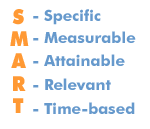
|
Improve Results by Setting GoalsHow to Set "S-M-A-R-T" GoalsWhen taking on any challenge, it�s a good idea to define your goals. You should identify what you want to accomplish and how you will carry out your plan. This is important when making positive change and will help you succeed. Before starting this program, set short-term and long-term goals. These goals should be S-M-A-R-T: 
For example: A specific short-term goal may be to start strength training; the long-term goal may be easing the symptoms of diabetes, improving endurance, or controlling your weight. This goal is easily measurable: Have you or have you not begun the program? Indeed, this is an attainable goal, as long as your doctor approves, and this goal is certainly relevant to living a long, healthy life. Your goal should be time-based: you should read this book within 5 days, buy the equipment you need, and set your exercise schedule within the next 5 days. Start the program within the following 2 to 3 days. The goals and time frame are entirely up to you. You may want to focus your long-term goals on improving a specific health condition, such as controlling diabetes, increasing bone density to help combat osteoporosis, or increasing muscle mass to help with weight control. Or your goal may be to finish a marathon or play tennis, or perhaps to simply . Your success depends on setting goals that are truly important to you�and possessing a strong desire to achieve them. Next: Making Goals Real: Writing Them Down Adapted from: Motivation: Define Your Goals
|
|
||||||||||||||||||
|


